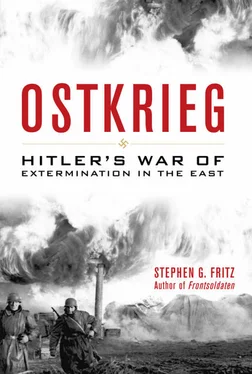Nor was this merely an empty planning exercise. Goebbels recorded in his diary on 26 July 1940, “[A] great plan for the evacuation of the Jews from Berlin has been approved. For the rest, all remaining Jews of Europe are to be deported after the war to Madagascar.” As late as 17 August, Goebbels still believed this solution to be operative, first noting harsh measures to be taken against enemies of the state, then remarking, “Later we will ship the Jews off to Madagascar. There they can build their own state.” 43For all the Nazis’ hopes and expectations, however, by the late summer it had become clear that the Madagascar Plan had foundered on an insurmountable hurdle: as long as Great Britain remained in the war, the Germans had neither the means nor the opportunity to deport millions of Jews to the distant island. Once again, military triumphs had compounded the Jewish problem by adding more Jews to the German Empire and raised the possibility of a territorial solution, only to result in a frustrating dead end.
In the year since the beginning of the war, Nazi planners had sought to engineer a demographic reorganization of the German sphere based on racial principles, only to be stymied by circumstances. The connection between the war and developing racial policy was clear, if frustrating: military triumphs brought the possibility of Lebensraum along with the nightmare of millions of “alien peoples” under German occupation. Moreover, the Jewish problem had mushroomed in scale. Where his original intent had been to free Germany from the alleged Jewish yoke, Hitler now perceived the need for a European-wide solution. The Nazis, however, increasingly came to understand that they could not effect a final solution to the Jewish problem because they could not end the war, and every effort at a suitable interim solution ended in frustration. These false starts with possible interim solutions, however, provided valuable practical experience in matters such as transportation, logistics, and deception that would later be applied in a more sinister environment. The clear trend in Nazi racial policy was in the direction of a steady radicalization. While Hitler provided the general direction and aims, his subordinates scrambled in a frantic example of “institutional Darwinism” to win his favor, with each impasse prompting the consideration of ever more radical schemes. The Nazis were clearly feeling their way in a process of trial and error, but each successive stage resulted in more ruthless and expansive racial plans than the one before. As summer 1940 gave way to autumn, Rademacher’s earlier question, “Whereto with the Jews?” remained as vexing as ever.
“What now?” That had been Hitler’s comment on hearing the news of the British declaration of war on 3 September. The German-Soviet Non-aggression Pact of 23 August—that pact “with Satan in order to drive the devil out”—had failed in its central purpose of preventing an Anglo-French intervention, but it had provided Hitler the protection and resources he needed to make quick work of Poland. After a desultory peace offer to Britain and France on 6 October, which he likely never expected to succeed, Hitler answered his own question with an insistence on an attack in the west as soon as possible since Germany could proceed in the east only when its borders in the west had been secured. “Time,” Hitler asserted in late September, “will in general work against us when we do not use it effectively. The economic means of the other side are stronger…. Time does not work for us in the military sense either.” In making this judgment, Hitler looked to the east as well as the west, for he now found himself in the uncomfortable position of economic and strategic dependence on the one state whose destruction was key to his ideology. Russia, he remarked to his top commanders a few weeks later, would remain “dangerous in the future.” While “shocking reports” of Soviet actions in Poland confirmed Hitler’s belief in the destructiveness of Jewish-Bolshevism, the manifest deficiencies of the Red Army in the autumn of 1939 seemed to make apparent the “catastrophic condition” of this “gigantic colossus.” Germany, therefore, had a brief window of opportunity that had to be exploited. What Hitler had in mind in October 1939, however, in no way resembled what eventually resulted: a rapid and brilliant blitzkrieg rout of his Western enemies. Instead, he envisioned simply a limited operation to push the western armies out of the Low Countries and northeastern France, seize the Channel ports, and make Germany less vulnerable to Allied counterattack. 44This would then allow him to turn his attention back to the east.
Even that limited scenario, however, horrified his generals. Acutely aware of Germany’s economic difficulties, raw materials shortages, and military deficiencies, they had risked everything in throwing virtually all German military force against Poland. That gamble had succeeded thanks to French inaction, but the French certainly would not remain passive in the face of a direct German assault. Having witnessed first-hand in World War I the tough fighting qualities of the French soldier, virtually all German commanders agreed that Hitler’s ideas were a recipe for disaster. The army would need months of refitting and retraining before it was again ready for action, almost half of its soldiers were over the age of forty, and a desperate shortage of equipment limited its striking power. To take just one example, motor vehicles were in such short supply that Halder suggested a “demotorization program” that entailed a “drastic and ruthless restriction of motor vehicles in existing and newly activated units.” Amazingly, with the spectacular blitzkrieg success looming, the chief of staff of the German army proposed that the horse take the place of the engine. Nor could the shortages be made good quickly since the German armament and economic mobilization plans had been based on the assumption that the war in the west would be a repeat of the attrition struggle of World War I. Only in October 1940 would a significant increase in production be achieved, with maximum levels of output not projected until the autumn of 1941. Nowhere in these economic plans can one detect a clear tactical or strategic blitzkrieg concept. 45
From the German perspective, the situation appeared gloomy in the extreme. One leading expert, in fact, has likened the Wehrmacht in the autumn of 1939 to a “lance whose point consisted of hard steel, but [whose] wooden shaft looked… ever more brittle.” Hitler’s generals, aware of their inferiority in both quantity and quality of weapons, numbers of soldiers, and economic preparation, were virtually unanimous in their rejection of an immediate attack in the west, which they considered tantamount to suicide. Colonel-General Walter von Reichenau, widely considered to be a “Nazi general,” called an attack in the autumn of 1939 “just about criminal,” while the head of the Oberkommando der Wehrmacht (OKW), the otherwise obsequious Wilhelm Keitel, regarded the idea as so crazy that he offered his resignation. An autumn attack on France so distressed Halder that he, not for the first time, sounded out like-minded individuals about the possibility of a coup d’état. Following a stormy meeting on 5 November with Brauchitsch, the head of the OKH (Oberkommando des Heeres, or Army High Command), at which Hitler berated the defeatism of his generals and raged against the sabotage emanating from the army command, Halder panicked and had all incriminating plans destroyed. Still, the situation seemed so desperate that he toyed with the idea of assassinating the Führer. “Amid tears,” a close associate noted later in his diary, “Halder said that he had for weeks had a pistol in his pocket every time he went to Emil [the plotters’ code name for Hitler] in order possibly to gun him down.” 46In the end, however, Halder lost his nerve and could not bring himself to violate his soldier’s oath of personal loyalty.
Читать дальше












